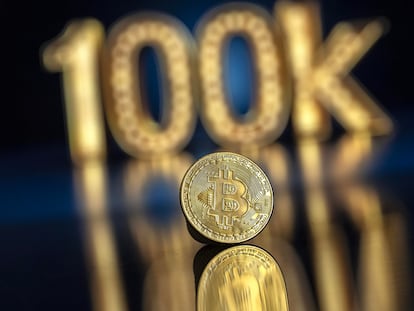Rupert Rucker of Schroders: ‘Small and mid-cap US stocks have been ignored for years and are at good prices’
The British Wall Street expert is optimistic, saying that ‘for the US economy, there’s nothing to really stop the current momentum’

Rupert Rucker (United Kingdom, 57 years old) has an unusual background for an investment director, the role he plays at asset manager Schroders, where he oversees U.S. small and mid-cap equities. Having graduated with a degree in classical philology and served as an officer in the British army for nearly four years, he now resides in London, where he runs a fund that invests in small and mid-cap U.S. companies, as well as two others that focus on impact investing. “Understanding ancient history and Latin is a combination of really trying to work out what happened on the basis of very little information, from either inscriptions or papyrus,” he says. That’s not so very different from interpreting financial markets, he says on a brief, 24-hour visit to Spain he made on the way to Italy.
Question. A lot of investors are making money now with the Magnificent 7. Why should people invest in small and mid-cap stocks?
Answer. The Magnificent 7 have made people a lot of money for a few years now. They’ve dominated stock markets not just in the United States, but around the world, particularly Nvidia and Microsoft, because there’s been a lot of money invested in the AI infrastructure, as well as in TSMC, the semiconductor manufacturer. So, why change now? Because this is all starting to spill out. Investment can’t go on forever at the rate that it’s been going. We can go back and think about what happened in 2000, when the internet was built. At that stage, we had a similar, huge investment and there was another big bubble. Cisco was the kind of equivalent of Nvidia then. But it took another few years for the internet infrastructure to be used by companies. We’re at a similar stage now where the AI infrastructure is being built, with data centers and LLMs (large language models), and that really benefits smaller companies because the data centers themselves, they need better energy usage and better cables. So, we expect that the money flow in the large-caps will start to wear off. It’s not going to end, but that flow will start to benefit more smaller companies. Whereas the larger caps are overvalued, smaller companies have just been so completely ignored for so many years that they really are at good prices for us to benefit from all of the added demand that’s coming through.
Q. Even so, the small-cap U.S. index Russell 2000 has grown by 20% in 2024. Are U.S. stocks overvalued?
A. No, statistics demonstrate that even though the markets have been strong, it’s just playing catch-up, and earnings have been strong as well. Valuations in small and mid-caps in the United States are pretty much the same as international equities. Much cheaper than, obviously, the large-caps, but they’re not trading at a premium to international equities, which they normally do. There are similar prices to what you’re paying in Europe and Asia, but you get a much better economy. There is also significant growth in the U.S. economy, which is going to be sustainable and quite robust. And we can’t underestimate the U.S. consumer, who continues to spend money and have unbelievable wealth, really, compared to the rest of the world. Now, you have to be careful because that consumer spending can be quite inflexible. You have to find the right company, and active fund management is extremely important.

Q. Do you see any risk on the Trump expectations? The U.S. markets have reacted very strongly.
A. I think there’s a short-term kind of market risk of too much enthusiasm, like the rise of bitcoin to $100,000. But that is very short-term. It’s inevitable that when he’s inaugurated, the markets will kind of pause, and we don’t know when or what the catalyst will be, and that maybe takes a bit of money off the table to really assess what he can or cannot do. But we kind of know what he wants to do initially, around immigration and tariffs. And those are two areas that he can address himself, he doesn’t need Congress. In terms of tariffs, he’s earmarked China, Canada and Mexico. The rest of the world is trying to understand what he’s going to do. But I think for the U.S. economy, there’s nothing to really stop the current momentum, which is pretty strong as we go into 2025, such that we’re probably going to get another over 2% growth, which is really strong for an economy of that size. You’re starting to see what they call “animal spirits.” People, businesses, banks, investment banks that have been waiting to see who was going to become president. And because it’s Trump, who likes markets and deregulation, you’ve started to see many more mergers and acquisitions. You’ll probably see much more IPO activity next year. This is all good for small-caps, because it means money is flowing into areas other than the Magnificent 7.
Q. What are the most attractive sectors?
A. There are a lot of areas, but I’ll highlight three. Firstly, there are the companies that I’ve been talking about that are going to help this AI spillover, IT service companies and infrastructure companies that make optical cables and reduce energy usage. Then, healthcare is a very big sector in the United States, and there are certain areas that are interesting. There are companies that now help patients get out of the hospital much more quickly than before. Before, you would have had to spend days or even weeks in the hospital recovering, now there is a whole infrastructure to enable patients to come home much earlier and be treated at home by these companies, thanks to the technology of monitoring systems that are now very sophisticated and allow the monitoring of a patient at home in a way that is similar to the hospital. We’re investing in not only the companies that facilitate the patient at home, but also the technology companies that have developed these devices. The third area is really about where the American government is spending its money. Under the Democratic Biden administration, they announced some very, very big acts to support investment in America, like the CHIPS Act, the Infrastructure Act and the Inflation Reduction Act, which touched a lot of industries, not just those of renewable electricity and energy, but also waste disposal.
Q. How do you choose stocks?
A. We can work out where we don’t want to invest quite easily. In the United States, in the Russell 2000 particularly, there are a lot of companies that don’t make any profits. It’s what makes America different, and in many ways, it is a strength of their economy that they have this creative destruction ability, where they’re able to spend a lot of money, and if it doesn’t work, it’s not the end of the world. I don’t think we have this attitude in Europe. That means there are lots of companies, particularly biotech and software, where their business model is not going to work. Investors may buy 10 of these companies in the hopes that one works. Even if nine don’t, the one that works makes huge amounts of money. We avoid the companies that don’t make any profits. For us, it’s not worth the risk. That means that we don’t really invest in quite a bit of the index, and that we then concentrate on companies that have established businesses. There are thousands of stocks, and we’re really able to differentiate better-quality companies, and that’s our skill. Now, what do we define as quality? Because this is a word that every active firm manager will use. We basically are looking for a company that, within its industry, is one of the strongest, with higher margins, with a particular product or service that hasn’t been priced into the market and has some growth potential.
Q. What is the minimum market cap you take?
A. The minimum is around $750 million, which is quite big. But the average size of a company in our portfolio is just under $8 billion. So, they are really big companies, which means low risk because there is plenty of liquidity to buy and sell the shares. The companies are very well-established already, mainly because they have this huge marketplace of the United Sates in which to operate. In Europe, there’s, of course, the EU, but it still involves going across borders. It’s not as easy as being in the United States where, although there are certain state restrictions, you can still get set up across the country very easily. And that is a massive difference.
Q. You also direct an impact investment fund. Will it be impacted by Trump’s intention to promote fossil fuels?
A. There’s a huge opportunity for our impact fund, because it’s not just about environmental investing. I think this is a kind of misconception. If I look at our portfolio, literally over 25% of the companies we’re investing in have to do with health and wellness. America is a very rich and a very big country, but that doesn’t mean that it doesn’t have problems. The companies we’re investing in are trying to solve them, in areas like infrastructure and water treatment, given that access to water in some parts of the country is not guaranteed. There aren’t many companies in the United States that we can invest in, in terms of proper renewable energy. So, it’s more the healthcare side.
Sign up for our weekly newsletter to get more English-language news coverage from EL PAÍS USA Edition
Tu suscripción se está usando en otro dispositivo
¿Quieres añadir otro usuario a tu suscripción?
Si continúas leyendo en este dispositivo, no se podrá leer en el otro.
FlechaTu suscripción se está usando en otro dispositivo y solo puedes acceder a EL PAÍS desde un dispositivo a la vez.
Si quieres compartir tu cuenta, cambia tu suscripción a la modalidad Premium, así podrás añadir otro usuario. Cada uno accederá con su propia cuenta de email, lo que os permitirá personalizar vuestra experiencia en EL PAÍS.
¿Tienes una suscripción de empresa? Accede aquí para contratar más cuentas.
En el caso de no saber quién está usando tu cuenta, te recomendamos cambiar tu contraseña aquí.
Si decides continuar compartiendo tu cuenta, este mensaje se mostrará en tu dispositivo y en el de la otra persona que está usando tu cuenta de forma indefinida, afectando a tu experiencia de lectura. Puedes consultar aquí los términos y condiciones de la suscripción digital.
More information
Archived In
Últimas noticias
Charles Dubouloz, mountaineering star, retires at 36 with a farewell tour inspired by Walter Bonatti
From the White House to diplomatic gifts: Lego wins over adult fans, brick by brick
Kate Winslet makes her directorial debut: ‘There aren’t more female directors because we’re busy raising children’
ChatGPT fails the test: This is how it endangers the lives of minors
Most viewed
- Families demand repatriation of bodies of Colombians who died in Ukraine: ‘This war is a slaughterhouse for foreigners’
- The low-cost creative revolution: How technology is making art accessible to everyone
- Liset Menéndez de la Prida, neuroscientist: ‘It’s not normal to constantly seek pleasure; it’s important to be bored, to be calm’
- Christian Louboutin: ‘Young people don’t want to be like their parents. And if their parents wear sneakers, they’re going to look for something else’
- Christmas loses its festive spirit: ICE fears cast shadow over religious celebrations











































